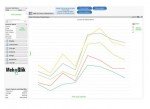No Digital Signage Solution without a display – the most obvious rule of the industry locates the display producers at the heart of the Digital Signage value chain. The close relation between the public display producers and the Digital Signage industry makes it particularly important to have an in-depth overview of the display market. As the tracking of hardware is a highly specialized segment of IT market research, only a handful of companies can offer a quality product with a regional breakdown. Therefore invidis consulting GmbH have decided to cooperate with the display and monitor tracking specialist Meko Ltd. the UK to further enhance the research and consulting quality. Invidis.de has talked to Bob Raikes the principal of Meko to get a firsthand impression of this interesting business.
invidis: Bob, can you give us some brief details about you and what your company Meko is doing?
Bob: Meko is the top specialist market research consultancy that is dedicated to the display industry in Europe. We have analysed and reported on the market for twenty years and produce a weekly newsletter and data on the European Public Display and Desktop Monitor markets.
invidis: Which parts of your business is important for companies from the Digital Signage industry?

Bob: We have been tracking the Public Display market in EMEA for ten years. The Digital Signage segment is the main application of public displays. Although only a part of the full Digital Signage solution, the display is the visible part of the system, so developments in displays often enable new applications and opportunities in the market.
invidis: What makes Meko unique and what are the greatest challenges your research team is facing?
Bob: Focus and experience are our unique attributes. Our relentless concentration on the display industry means that we have many contacts around the world and understand the complete supply chain, from raw materials through to systems integrators. In digital signage, the biggest challenge is the forecast as the market size is often impacted by single projects at this stage of its development.
invidis: You are tracking the public displays market in Europe since 2004. Can you give us a short overview on how the market has evolved since you started your business?

Bob: The big change has been in the rate of growth. From 2004 to 2008, growth was very limited, although many stakeholders in the digital signage market were very optimistic of very rapid growth. There were many pilot schemes, but a lot of them didn’t get rolled out. In 2008, the economic crisis hit the market, but in 2011, the market started to really take off. The development of better software and networks, as well as a better understanding of how to use digital signage has meant good growth in recent years.
invidis: From your perspective – concerning technology trends and commercial effects – which were the most important key developments in the public display industry in the last 10 years?
Bob: From the display side, the key development was the building of LCD factories that could economically make panels of larger sizes. LCDs are made on big sheets (substrates) of glass that are then cut into panels of the final sizes. In 2004, the “state of the art” in LCD making was G6 – with substrate sizes of 1.5m x 1.8m and optimized for 32” (8 per sheet) or 37” (6 per sheet). Substrate sizes were boosted through G7 and G8 and in October 2009, Sharp started production of G10 sheets (2.88m x 3.13m) which could efficiently make 60” (8 per sheet) and 70” (6 per sheet). This has driven down the cost of larger displays.
The second innovation that is important is the use of LEDs for backlights and the most recent change is the addition of “Smart” functions to displays, although the effects of this change have not yet worked through to the market fully.
invidis: The last three years saw very strong market growth in the DACH region. What are your expectations for this year?
Bob: We do expect to see growth of 15% in display volumes in the region. The DACH region saw very good growth in 2012, but growth slowed during the year – which was in contrast to the rest of Europe. It may be that the relatively well developed DACH market has hit a “Trough of Disillusionment” as is sometimes seen in the famous “Hype cycle”. We are confident that the market will recover from this, but with slower growth than in the “peak of hype”.
invidis: Thank you Bob very much for the interesting insights
Meko Ltd. and invidis consulting GmbH are cooperating in research on the Digital Signage Market in Europe. The general manager of Meko Bob Raikes will feature with a monthly column on invidis.de. Bob will also be speaking at the 8th Munich Digital Signage Conference 2014 (17th/18th September). To get the most up to date news from the public display market you can register here for the Meko newsletter.
